Ritterschlucht
Useful Information
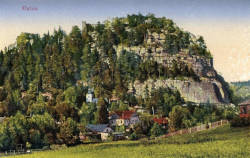
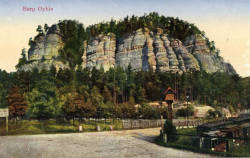
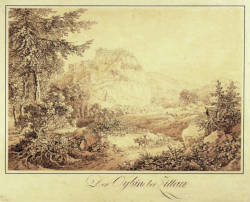
| Location: |
Ritterweg, 02797 Oybin.
(50.843694, 14.739728) |
| Open: |
no restrictions. Castle: APR to OCT daily 9-18. NOV to MAR daily 10-16. [2022] |
| Fee: |
free. Castle: APR to OCT: Adults EUR 8, Children (6-14) EUR 3, Students EUR 7, Disabled EUR 7, Families (2+*) EUR 20. NOV to MAR: Adults EUR 5, Children (6-14) EUR 1.50, Students EUR 4, Disabled EUR 4, Families (2+*) EUR 12. [2022] |
| Classification: |
 Gorge Gorge
|
| Light: | n/a |
| Dimension: | |
| Guided tours: | self guided |
| Photography: | allowed |
| Accessibility: | no |
| Bibliography: |
Eduard Eschke (1832):
Der Oybin und seine Ruine,
Zittau 1832

Christian August Pescheck (1804): Der Oybin bey Zittau, google books 
Anke Fröhlich-Schauseil (2019): Der Oybin und die Malerei der Romantik in der Oberlausitz, Katalog zur Ausstellung in den Städtischen Museen Zittau. Imhof Verlag, ISBN-10: 3731909073, ISBN-13: 978-3731909071. 
|
| Address: |
Fremdenverkehrsbetrieb Oybin, Hauptstraße 15, 02797 Kurort Oybin. Tel: +49-35844-7330.
E-mail: |
| As far as we know this information was accurate when it was published (see years in brackets), but may have changed since then. Please check rates and details directly with the companies in question if you need more recent info. |
|
History
| 1364 | Emperor Karl IV fortifies the castle and builds the Kaiserhaus. |
| 1369 | Emperor Karl IV donates a monastery complex on the castle hill to the Order of the Celestines. |
| 1577 | monastery burns down after a lightning strike. |
| 1681 | a rockfall destroys all buildings in front of the church. |
| 1795 | painted by Adrian Zingg (*1734-✝1816). |
| 1810 | painted by Caspar David Friedrich. |
| 1820 | painted by Carl Gustav Carus. |
| 1890 | stone bridge across the gorge built. |
Description
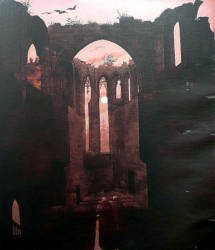
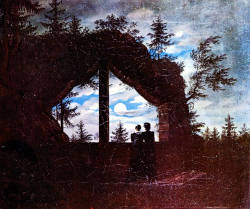
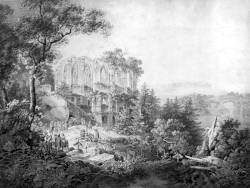
The Ritterschlucht (Knights Gap) is a vertical and straight crack in the rock, about shoulder wide. It looks quite natural, and there are actually numerous similar cracks in the red sandstone of the area, but this crack is part of the defenses of Oybin castle. Once there was a drawbridge across the gorge, today there is a massive bridge built of rock. It seems Medieval times are over, at least as long as the people do not start to fight for cheap gas.
The village Oybin is located south of Zittau at the German-Czech border, in an area called Zittauer Gebirge (Zittauer Mountains). Geologically it is actually the same as the nearby Elbsandsteingebirge, which is 35 km to the west. Red sandstone was deposited during the Cretaceous, and later eroded to form strange rock formations. Above the town Oybin is a craggy cliff which resembles a beehive. In the early Middle Ages it was used to build a castle.
In the early 14th century the castle was massively expanded at the beginning of the 14th century into a fortified complex, intended to protect two trade routes leading over the mountain pass. The Bohemian king and German emperor Karl IV erected a huge building called Kaiserhaus (imperial house) and donated a monastery for the Order of the Cölestines. The monastery church was constructed by the famous Prager Dombauschule (Prague cathedral building school), and is quite exceptional. For the next 200 years the monastery and the fortification existed on the two neighbouring rocks. But Reformation and Counter-Reformation put an end to monastic life. In 1577, the barely used complex burned down after a lightning strike. A rockfall in 1681 destroyed all buildings in front of the church, only the Bibliotheksfenster (library window) remains and gives an impression of the beauty of the destroyed buildings.
Alexander Thiele, the court painter of Friedrich August III, was the first to paint Oybin with its ruins overgrown by nature during the 18th century. Others followed, like Adrian Zingg (*1734-✝1816) in 1795, Caspar David Friedrich (1810), and Carl Gustav Carus (1820). The Brothers Grimm (the other two) found a popular legend here for their collection. As a result the ruins were widely known in the 19th century.
In Lusatia, not far from the Bohemian border, there is a steep rock called Oybin, on which people used to show and tell stories about the Jungfernsprung: A long time ago, a virgin came to visit the now ruined mountain monastery. A brother was supposed to show her around and show her the passages and wonders of the rocky region; her beauty awakened a sinful lust in him, and he criminally stretched out his arms towards her. But she fled and escaped, pursued by the monk, along the winding path;
suddenly she stood before a deep chasm of the mountain and jumped chastely and courageously into the abyss. Angels of the Lord seized her and carried her gently down without any harm.
Others claim that a hunter saw a beautiful peasant girl walking on the Oybin and rushed at her. Like a hunted deer, she plunged through the rocky passages, the gorge opened before her eyes, and she leapt down to the ground unharmed.
Still others report: A quick girl bet her playmates that she would jump over the gorge. But as she jumped, her foot slipped out of the slippery slipper and she would have been crushed if her hoop skirt had not fortunately protected her from all sides and brought her gently down to the depths.
The Maiden’s Leap, Brothers Jacob and Wilhelm Grimm
Today the site is a museum, tourist site and restaurant. There are numerous trails from the village to the castle, and the gorge is one of them, especially popular among families with children.
 Search DuckDuckGo for "Ritterschlucht"
Search DuckDuckGo for "Ritterschlucht" Google Earth Placemark
Google Earth Placemark Vorburg
Vorburg  Index
Index Topics
Topics Hierarchical
Hierarchical Countries
Countries Maps
Maps